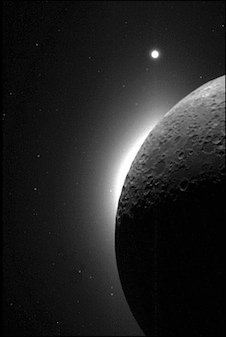Hello Steemians! My plans for today's post were different, but owing to a silly cold that's made me weak and gave me an even more silly headache, I took my medicine, got under my warm blankets inside my fluffy robe my mum bought me two New Years ago, put some depressing greek music on and started hitting on my keyboard. The outcome? Read below a mixture of science, fantasy and an incurable disease...romance.
Do you know of the Lunar Horizon Glow?
It's a bright crescent near the moon's horizon first observed by the Apollo missions astronauts about 50 years ago. The beautiful sight was visible near sunset and before sunrise. After the glow was gone at sunrise there were also some faint light beams. Theories trying to explain its origin supported that it was dust particles in the really sparse lunar atmosphere. The dust scattered light from the sun, giving the moon this wonderful phenomenon.
Where does the dust come from?
When meteorites and asteroids hit on the moon, they provide it with loads of dust particles. During the crash, there is so much energy that melts moon's surface into vapor. Later on, as the vapor cools down and condenses, the particles are coated by a "glassy shell".
How does the dust stay up in the "air"?
Ionization! Since there are no gusts of wind or water to vaporize and cause motion within the atmosphere, charging of particles works as an alternative motion mechanism. This mechanism works hard to maintain the cloud of dust above the surface, sometimes even as high as 250 kilometers. As micrometeorites hit on the lunar surface they create charged and neutral clouds of dust in the first place. They also cause lunar dust particles to rise from the ground. So we have two sources of particles, one external (the meteorites) and one internal (lunar ground).
Electric fields generated by the day-night circle of the moon probably keep the cloud moving. One theory would say that, as daylight heats up dust particles, they release electrons probably ending with a positively-charged part of the lunar surface. During night time, dust particles receive electrons from the solar wind (plasma) and we end up with a negative charge. Owing to the same-charge repulsion, dust particles could hover at almost a meter above the ground. As the sun wipes out the lunar surface, negative charges could be changed into positive and the other way round. An electric field of gigantic dimensions could hurl the dust particles hundreds of meters into the sky, before they start coming down to bounce up again like a fountain. This recycling works to scatter sunlight.
At the end of last year (2016) we were informed by NASA that they might have figured out how this "circulation" works (not completely, but it's a step in understanding the phenomenon better). After performing lab experiments, scientists believe they know how dust particles move around over airless celestial bodies.
It's the Sun! UV radiation and plasma strikes have the ability to loft dust particles. What happens exactly? Neighboring particles give away electrons and then take them back within the limits of "micro-cavities" between them. This creates high electrical charges leading to strong repulsive forces between the particles that push them high above the ground.
Static electricity can explain very well how this "dusty mass" moves around the moon and why not other celestial bodies. Scientists now believe they can expand their hypotheses in more airless environments, like the ponds on Eros asteroid or between Saturn's rings. Even though they have made progress those past few years, more research needs to be done.
Oh boy, there are so much we don't know...

And a small dose of fiction...
- Mum, what is the moon made of?
- What do you think, sweetheart?
- Is it made of light?
- No, it's made of hidden love...
- Mum, are you silly?
- No dear. It's true. The moon has only one side that shows us, the bright pale one, but there is also another one, dark, hidden... That's where it keeps all the love that people send it. All the hopes and wishes and dreams that are left unfulfilled, all the frustration in their hearts. In order to see it you need to get off this earth and fly! Fly to get behind it. And if you get close enough you'll see it. It will be right there in front of your eyes, a lovely glow around the horizon, the light of love, the light of life, the light of all those feelings we sometimes fail to express, admit and confess. The light that burns us without turning us to dust...

References
space.com
iflscience.com
phys.org
sciencealert.com
nasa.gov
Thank you for stopping by and giving this post a read. I hope you enjoyed it! If you please, feel free to pay a visit to my blog and check out my short stories along with plenty of educational posts and of course my bizarre natural phenomena series.
Special thanks and mentions go to:

Until my next post,
Steem on and keep smiling, people!




